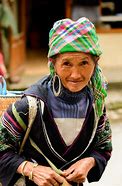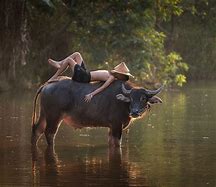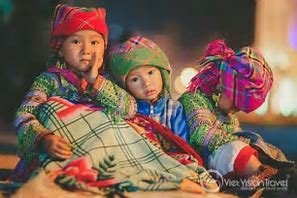
Vietnam Population 2021 (Live) 98,392,573 Given Vietnam's turbulent history, the country is making great strides in population growth. Currently, Vietnam's population is 97.3 million people, a number expected to hit 100 million by the end of 2024. This article is about the demographic features of the population of Vietnam, including population density, ethnicity, education level, health of the populace, economic status, religious affiliations and other aspects of the population.
Originating in northern Vietnam, the Vietnamese people pushed southward over two millennia to occupy the entire eastern seacoast of the Indochinese Peninsula. Ethnic Vietnamese, or Viet (known officially as Kinh), live in the lowlands and speak the Vietnamese language, as opposed to the many ethnic groups of Vietnam who are known to occupy the mountainous regions. The Kinh group does represent much of the cultural and political landscape of Vietnam.
The Vietnamese government recognizes 54 ethnic groups, of which the Viet (Kinh) is the largest; according to official Vietnamese figures (2019 census), ethnic Vietnamese account for 85.32% of the nation's population and the non-Vietnamese ethnic groups account for the remaining percent. The ethnic Vietnamese inhabit a little less than half of Vietnam, while the ethnic minorities inhabit the majority of Vietnam's land (albeit the least fertile parts of the country).
The relation between China and Vietnam also declined following reunification in 1975, with Vietnam siding with the Soviet Union against China in the Chinese-Soviet split. Tensions peaked when Vietnam and Cambodia started a war, Cambodia lead by Pol Pot being a Chinese ally, resulting in a Chinese invasion of Vietnam in 1979. In 1978-79, some 450,000 ethnic Chinese left Vietnam by boat as refugees (many officially encouraged and assisted) or were expelled across the land border with China. In recent years the government has performed an about turn and is encouraging overseas Hoa to return and invest, but the ethnic Chinese population has been in continuous decline since the 1970s due to assimilation and low birth rates.

The central highland peoples commonly termed Degar or Montagnards (mountain people) comprise two main ethnolinguistic groups--Malayo-Polynesian and Mon–Khmer. About 30 groups of various cultures and dialects are spread over the highland territory. Other minority groups include the Cham—remnants of the once-mighty Champa Kingdom, conquered by the Vietnamese in the 15th century, Hmong, and Thái. This article is about the demographic features of the population of Vietnam, including population density, ethnicity, education level, health of the populace, economic status, religious affiliations and other aspects of the population.
Ethnic Vietnamese, or Viet (known officially as Kinh), live in the lowlands and speak the Vietnamese language, as opposed to the many ethnic groups of Vietnam who are known to occupy the mountainous regions.
The Kinh group does represent much of the cultural and political landscape of Vietnam. The Kinh Vietnamese dominated government media propagate negative stereotypes of the highlander ethnic minorities, labeling them as "ignorant", "illiterate", "backward" and claim that they are impoverished and underdeveloped because of their own lack of economic and agricultural skills. The ethnic Kinh settlers in the highlands have negative stereotypes and views of the highlanders with barely any intermarriage and little interaction since they deliberately choose to live in different villages with other ethnic Kinh. The Vietnamese government has promoted the ethnic Kinh migration to the highlands as bringing "development" to the highlanders.Montagnards are made up of many different tribes that are indigenous to the Central Highlands of Vietnam. In the past, Montagnards were referred to as "mọi" (savages), by the Vietnamese. Vietnamese textbooks used to describe Montagnards as people with long tails and excessive body hair. Nowadays, the non-offensive term "người Thượng" (highlanders), is used instead.

In 1956, President Ngô Dinh Diêm launched programs to resettle ethnic Kinh Vietnamese and northern ethnic minorities into the central highlands. These programs also sought to assimilate the Montagnards into mainstream Vietnamese society. This was the beginning of the struggle between ethnic Kinh and Montagnards. After the Vietnam war, the government further encouraged the ethnic Kinh to resettle in the highlands to cultivate coffee after the demand for coffee in the world boomed.
Approximately 1,000,000 ethnic Kinh were forcibly resettled to the central highlands. This resettlement caused conflict between the ethnic Kinh and Montagnards because the Montagnards believed the ethnic Kinh were encroaching on their land.
This conflict lead to resentment from the Montagnards which lead to some deadly protests against the ethnic Kinh. Montagnards have faced religious persecution from the communist Vietnamese government since the end of the Vietnam war. The Vietnamese government has a list of government-approved religious organizations and requires that all religious groups register with the government. Any religious groups that are considered to be going against national interests are repressed and shut down. The Vietnamese government claim the independent Montagnard religious groups use religion to incite unrest. They use this to justify their capture, detainment, and interrogation of Montagnard political activists, leaders, and shut down of unregistered Montagnard churches. Followers of unregistered churches and religious activists have also been harassed, arrested, imprisoned, or placed under house arrest by authorities.